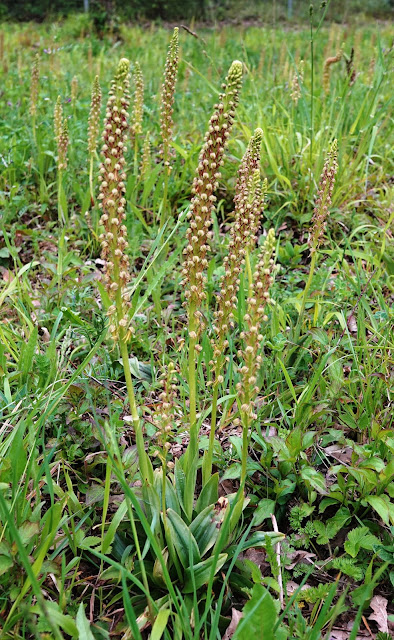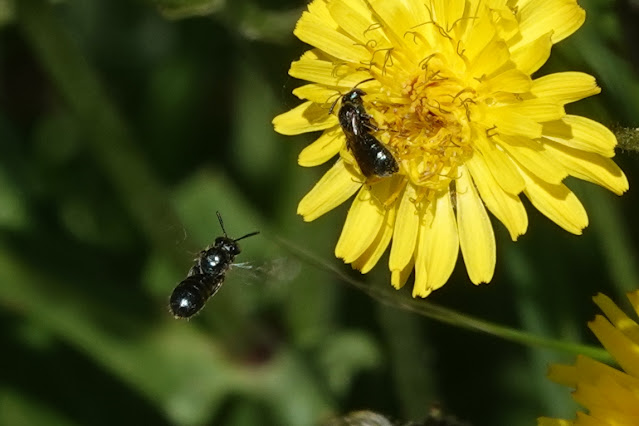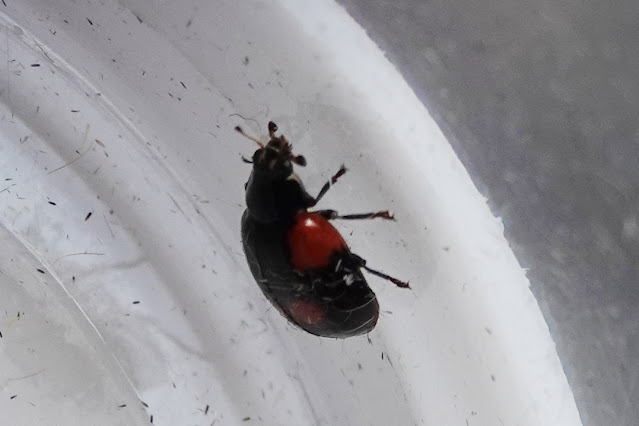I worked through the Bank Holiday at Rainham and as expected it was busy but I still managed to snaffle a few minutes here and there with the camera and even completed a full circuit with a few jobs in hand on Thursday.
The weather had at last started to improve by Thursday 27th and my jobs took me down toward the woodland to start with where there were many distractions along the way. I had been bemoaning the fact that I had almost got to the end of May without a single species of Odonata but thankfully this was quickly remedied with numerous Blue-tailed and Azure Damselflies and a few teneral Common Blues.
 |
| All Azure Damselflies |
I found plenty of Dock Bugs and a smart Hairy Shieldbug as well as my first Wasp Beetle for many years which was smaller than I remembered. Seven, 14 and 24 Spot Ladybirds were dotted around and Nettle Tap moths were, umm, on the Nettles.
7 Spot Ladybirds 14 Spot Ladybirds 24 Spot Ladybird Dock Bug Hairy Shieldbug Wasp Beetle
Nettle Tap
As ever hoverflies distracted me and a amongst a few regular species were the first Tropidia scita and Parhelophilus sp of the year. I did not bother catching the latter to check for the presence or absence of a hairy wart on the inside of the upper back leg...
Helophilus pendulus Parhelophilus sp Parhelophilus sp
Pyrochroa serriticornis and a Phyllobius weevil were seen and Pisaura mirabilis waited with legs tandemed on exposed leaves while Xysticus Crab Spiders lurked deeper into the folds. They always look like they have very grumpy old man faces.
Pyrochroa serriticornis Xysticus Crab Spider
Holly and Common Blues danced around with many Green veined Whites and the odd Peacock and Speckled Wood and I found an interesting Empid that I am awaiting some advice on.
I found three different Jumping Spiders with Zebra Jumper, the feisty Ant-mimic and the yellow palped Heliophanus although this one needs closer examination to get it to species.
female Heliophanus sp Synageles venator
Off toward the Ken Barrett Hide I found several male Red-tailed and Early Bumblebees on the Dandelions and Common Carders on the White Dead Nettles. There were several very red bodied small Nomada Bees which I think are Nomada fabriciana (for the moment!).
Bombus pascuorum Bombus lapidarius
Nomada fabriciana Nomada fabriciana
Kentish and Dark-lipped Hedge Snails were laying low in the Nettle beds and I found another Parhelophilus Hoverfly and a funky little Rove Beetle that I may just have pinned down the id on due to its dark knee joints!
 |
| Paederus fuscipes - Rove Beetle |
 |
| Lucilia sp |
 |
| Celery Leaved Buttercup |
There was a brood of Great Crested Grebes and one of Pochard on Aveley Pool and Bearded Tits were frantically foraging in the small reed island from the second platform before returning to the main Phrag bed. They were joined by Reed Warblers and two Reed Buntings and it was good to at last encounter several males of the latter in full song on the trails.
Five Hobbies suddenly appeared from nowhere to chase down aerial insects and Marsh Harrier and Buzzard were up over the back on Wennington. I had just been asked by a couple about Spoonbills and said that we had not one in May yet but there was always a chance when ten minutes later I got to the Target Pool platform to discover a fine breeding plumaged adult busily swing that amazing bill from side to side before occasionally coming up for air.
 |
| Spoonbill |
More Bearded Tits pinged around and several well grown juveniles were seen clambering through the reeds as I turned to head back to the Centre passing some young Lapwings in the Ouzel Field and a wondrous floral spread of Garlic Mustard on one side of the path and Cow Parsley on the other.
Marsh Frogs serenaded me on the way back and a fine female sat on the path for a while before leaping for cover.
Friday, as I have already written, was spent up in Cambridgeshire but on Saturday 29th I was lucky enough to get out for a couple of hours with as part of the Land of the Fanns Art Festival walk. Most of the small group had never visited the reserve before and I think that they were all impressed that there could be such a wondrous green space enclosed by so much modernity and industry. None of them had seen the Marsh Frogs before and they performed admirably for me and just after talking about the Thames having both Seals, ‘Bob’ the bull Grey surfaced mid-river on his daily float up river with the incoming tide. Two Harbour Seals were hauled up on the Kent side to give us an unusual double.
 |
| Marsh Frog |
 |
| Bob the Grey Seal |
 |
| Harbour Seals |
Sunday 30th saw me north of the river nice and early to give me enough time to get into Grays Gorge once again but this time with a Bird’s Nest Orchid map to hand. Thanks to Enid it was spot on and was soon lying down in the leaf little with these strange caramel brown flowers. I had only ever seen them in their final shrivelled days so it was good to find many with fresh flowers in their spikes and amongst the 30 or so seen was one particular clump that proved the most photogenic.
 |
| Bird’s Nest Orchid |
There were now many Twayblade out on flower and one or two Common Spotted while the Man Orchid spires were even more numerous and incredibly varied in colour. After my excitement of the yellow one at Ranscombe I was quite surprised to find lots like it here. For a subtle Orchid they are actually very easy to take loads of photos of! The Round leaved Wintergreen was now flowering too and there was a lovely patch of Sanfoin in shocking pink.
 |
| Twayblade |
 |
| Man Orchids |
Common Spotted Orchid and Twayblade Round leaved Wintergreen Sanfoin
Back at the reserve a quick look before work produced two Ring-necked Parakeets dropping down for a cautious drink on Purfleet Scrape and there were already two Harbour Seals beached on the Kent side.
The rest of the Bank Holiday was spent on Reception out the front of the building but with a few snatched moments with my camera around the closest vegetation and flowers. As it was it turned out to be very productive with the undoubted highlight being two brand new Hoverfly species. Both were troubling me and needed expert help to pin them down to species. Neither was illustrated in Ball and Morris and even they were confused to start with.
Anasimyia transfuga Anasimyia transfuga Meligramma euchromum Meligramma euchromum
The first Merodon equestris of the season in two colour forms and a female egg laying Eupeodes luniger were also seen on the same patch along with a host of bees that included many worker Early Bumble and Common Carders.
Merodon equestris
Eupeodes lunger
Tiny Little Blue Carpenter Bees with shiny white faces zipped in and out of the Beaked Hawksbeard that I had saved from the Black Ops mowing team where they were out-weighed by massive Small and Green veined Whites and Holly Blues.
Little Blue Carpenter Bees - Ceratina cyanea
Green veined White Holly Blue Holly Blue Small White
A very smart Ten Spot Ladybird was found along with many
Seven Spots and all were heading towards the Aphid laden Elders. There was a huge Queen German Wasp having a
wash and a very large, as yet, unnamed Tachinid was keeping an eye on her just
in case.
Ten Spot Ladybird Tachinid Tachinid German Wasp- Vespa saxonica
Closer leaf watching produced a Box Bug and my first Rambur’s
Pied Shieldbug of the year and I remembered to go and check the Pendulous Sedge
for the tiny bug, Cymus glandicolor that lives on it.
Box Bug Cymus glandicolor Rambur’s
Pied Shieldbug
My two days off were well spent ambling the Kentish countryside before a whole day back at Rainham watching a solid wall of rain falling in front of me yesterday. There were many swirling, screaming Swifts, a distant Cuckoo, some very wet House Sparrows and a couple of sensible Magpies that as usual sought shelter in the toddlers play house until they realised that it was never going to stop and came back out again!
And so to today, Saturday 5th June was spent with the same view but minus the rain and with glorious sunshine. The Hobbies were back and the Raven family seemed to enjoy getting harried by the Carrion Crows and Jackdaws before rolling back south towards home.
My flower patch again produced the goods with both Bryony Ladybird and Bryony Bees on the expected plant and the now flowering Dog Roses attracting Bumbles and a couple of big black Andrena pilipes while the Hawksbeard added another new species to my list with the red and black bodied Andrena labiata along with a very small Megachile with orange hairs underneath.
Bryony Bee - Andrena florea Andrena labiata
 |
| Andrena labiata |
 |
| Andrena labiata |
Early Bumblebee - Bombus pratorum Early Bumblebee - Bombus pratorum
 |
| Osmia bicornis - female |
 |
| Nomada goodeniana |
 |
| Honey Bee |
There was a late female Epistrophe eligans and both sexes of Eupeodes corollae as well as many Episyrphus balteatus but the surprise was another Anasimyia but not the A transfuga of last week but a female A.lineata instead.
Anasimyia lineata Anasimyia lineata Epistrophe eligans Episyrphus balteatus Eupeodes corollae
A Tropidia scita scurried around a leaf with his over developed hind femora. I pictured him down at the gym eyeing up the Eristalis tenax and wishing he could have thighs like that...
Harlequins and a black Two Spot Ladybird joined the list and a male Broad Bodied Chaser rocketed through but did not linger. Almost my last find of the day was this very funky little Picture Winged Fly that I think is the species that is tied to Sea Aster which of course grows not far away.
Harlequin Two Spot Ladybird Two Spot Ladybird
Campiglossa plantaginis - Sea Aster PWF
With the public all gone it was time for the House Sparrows to return to the tables and I left them in peace and headed for home.



















































































No comments:
Post a Comment